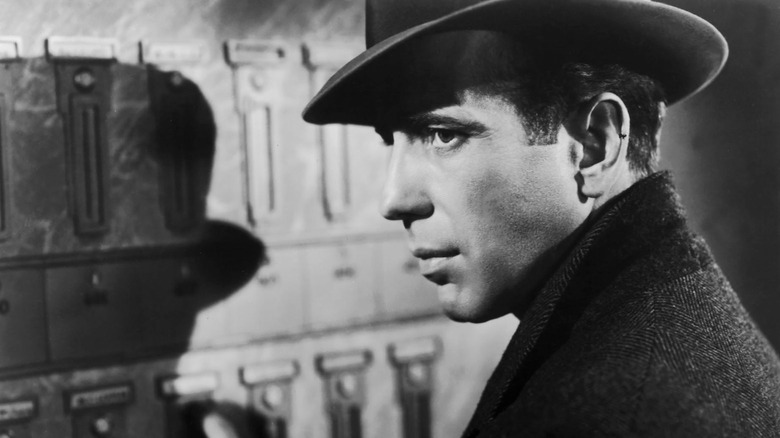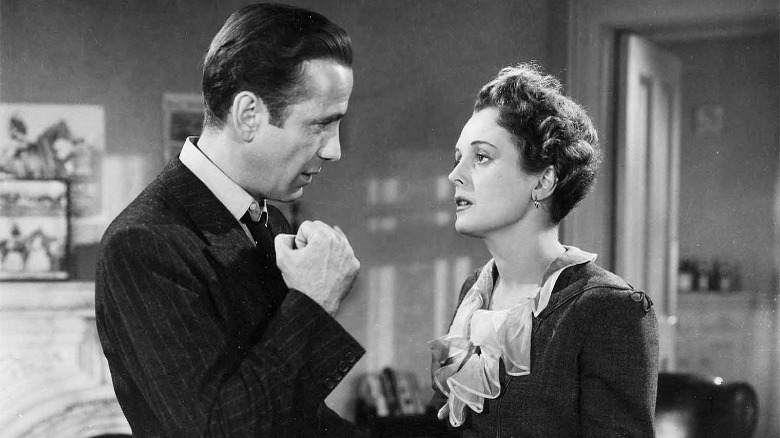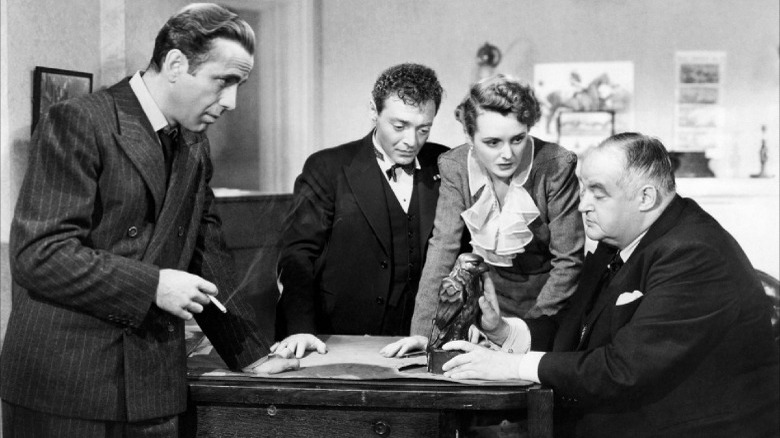The Daily Stream: The Maltese Falcon Is The Stuff Noir Is Made Of
(Welcome to The Daily Stream, an ongoing series in which the /Film team shares what they've been watching, why it's worth checking out, and where you can stream it.)
The Movie: "The Maltese Falcon"
Where You Can Stream It: HBO Max
The Pitch: My personal introduction to the world of hard-boiled noir and crime drama came in the form of "Calvin and Hobbes." Among the alter-egos Calvin would imagine for himself in Bill Watterson's exemplar comic strip was Tracer Bullet, hardened private eye, and notorious alcoholic.
"I keep two magnums in my desk. One's a gun, and I keep it loaded. The other's a bottle, and it keeps me loaded," says Tracer. In 1995's "The Calvin and Hobbes Tenth Anniversary Book," Watterson admitted he knew little to nothing about the world of film noir or detective novels. Tracer's overwrought voiceover and stories were merely the artist's "spoofs on the clichés of the genre."
By the time I finally came to see the granddaddy of noir films, John Huston's "The Maltese Falcon," I had similarly absorbed most of the movie through other parodies and pastiches. The film's protagonist, cynical private investigator Sam Spade, might not speak in voiceover, but his dialogue is just as pulpy and only a little less cheeky than Tracer Bullet's.
Kasper Gutman's manner of speech was also familiar to me. Frank Welker had clearly modeled his vocals after Sydney Greenstreet's delivery as the fastidious crook for his role as "Fat Guy" in "Garfield's Feline Fantasies," an animated short I re-watched many times on VHS as a kid. And what young millennial wouldn't recognize Gutman's associate, the queer-coded villain Joel Cairo, as being played by Peter Lorre, the zany "Looney Tunes" scientist who had apparently been in some other stuff?
Play it again, Sam
Humphrey Bogart stars in "The Maltese Falcon" as Sam Spade, a San Francisco P.I. who gets pulled into a tangled web of lies, betrayal, and murder, all of it involving the titular item — a priceless jewel-encrusted falcon statuette that only matters inasmuch as everyone in the film is after it.
To call Sam unsentimental would be putting it mildly. He's barely phased to learn his partner, Miles Archer (Jerome Cowan), has been killed shortly after taking on a suspicious new client. Miles' body isn't even cold when Sam kisses his widow on the mouth (the two, it would seem, have a history) and asks his secretary to remove the "Archer" from the title of their business. "He knew what he was doing. Those are the chances we take," Spade tells Brigid O'Shaughnessy (Mary Astor), the femme fatale who got him and Miles into this mess to begin with.
Bogart would come to specialize in playing these types of men, who hide their old wounds behind a sardonic mask and drink away the pain until they're numb. Spade is less tormented than the actor's other characters. At one point, he puts on a display of rage before storming out of a room and grinning to himself in the adjacent hallway, amused by his macho exhibit. Yet, his closing monologue ("When a man's partner is killed, he's supposed to do something about it.") and legendary final line ("The stuff that dreams are made of.") betray the heart still beating beneath his tough exterior.
Why it's essential viewing
"The Maltese Falcon" didn't conjure noir out of thin air, the genre's fatalism was born from the Great Depression and the rise of fascism leading into WWII (which the U.S. entered shortly after the film's release). It wasn't even the first movie based on Dashiell Hammett's 1930 novel of the same name. The book had already been turned into a movie twice — first in 1931 as Roy Del Ruth's "The Maltese Falcon" and then in 1936 as William Dieterle's "Satan Met a Lady" — by the time John Huston decided to adapt it for his directorial debut in 1941.
In spite of all that and its many, many spoofs (as well as quirky tributes like Rian Johnson's "Brick"), the film retains its ability to entrance. Huston's "The Maltese Falcon" is noir before noir. His script's punchy dialogue and colorful archetypes aren't clichés; they're the real deal, and even now, you can see why they would inspire so many tired copycats. The movie's performances are just as finely-tuned, hitting that sweet spot between theatrical and over-the-top cartoony.
Also missing are the genre's most familiar visual motifs, from the manufactured shadows to slanted camera angles that threaten to warp the scenery. In their place, Huston serves up claustrophobic frames and precise blocking, the kind that allows single-take scenes to play out without calling attention to the camera work. "The Maltese Falcon" walked so other noir movies could run, with more contemporary neo-noir films like "Sin City" pushing the genre's expressionist style to such an extreme that it borders on self-parody.
With Huston's movie, however, the bleakness and bitterness come across more as an authentic mood and not a juvenile attempt at edginess. Even the underlying misogyny and homophobia serve as a reminder: There are no heroes in noir.


